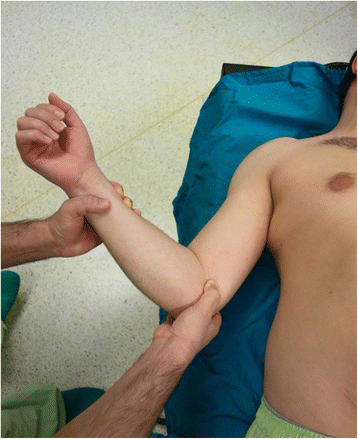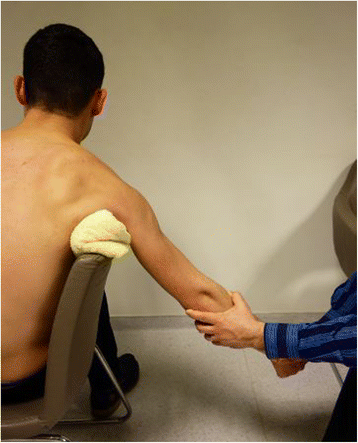Comparison of four different reduction methods for anterior dislocation of the shoulder
- PMID: 26016671
- PMCID: PMC4448546
- DOI: 10.1186/s13018-015-0226-4
Comparison of four different reduction methods for anterior dislocation of the shoulder
Abstract
Background: Shoulder dislocations account for almost 50% of all major joint dislocations and are mainly anterior.
Objective: The aim is a comparative retrospective study of different reduction maneuvers without anesthesia to reduce the dislocated shoulder.
Methods: Patients were treated with different reduction maneuvers, including various forms of traction and external rotation, in the emergency departments of four training hospitals between 2009 and 2012. Each of the four hospitals had different treatment protocols for reduction and applying one of four maneuvers: Spaso, Chair, Kocher, and Matsen methods. Thirty-nine patients were treated by the Spaso method, 47 by the Chair reduction method, 40 by the Kocher method, and 27 patients by Matsen's traction-countertraction method. All patients' demographic data were recorded. Dislocation number, reduction time, time interval between dislocation and reduction, and associated complications, pre- and post-reduction period, were recorded prospectively. No anesthetic method was used for the reduction.
Results: All of the methods used included traction and some external rotation. The Chair method had the shortest reduction time. All surgeons involved in the study agreed that the Kocher and Matsen methods needed more force for the reduction. Patients could contract their muscles because of the pain in these two methods. The Spaso method includes flexion of the shoulder and blocks muscle contraction somewhat. The Chair method was found to be the easiest because the patients could not contract their muscles while sitting on a chair with the affected arm at their side.
Conclusions: We suggest that the Chair method is an effective and fast reduction maneuver that may be an alternative for the treatment of anterior shoulder dislocations. Further prospective studies with larger sample size are needed to compare safety of different reduction techniques.
Figures
Similar articles
-
Chair method: a simple and effective method for reduction of anterior shoulder dislocation.Acta Orthop Traumatol Turc. 2012;46(2):102-6. doi: 10.3944/AOTT.2012.2676. Acta Orthop Traumatol Turc. 2012. PMID: 22491434
-
Reduction of anterior shoulder dislocations by Spaso technique: clinical results.J Emerg Med. 2008 May;34(4):383-7. doi: 10.1016/j.jemermed.2007.07.026. Epub 2008 Jan 28. J Emerg Med. 2008. PMID: 18226873
-
Reduction of acute anterior dislocations: a prospective randomized study comparing a new technique with the Hippocratic and Kocher methods.J Bone Joint Surg Am. 2009 Dec;91(12):2775-82. doi: 10.2106/JBJS.H.01434. J Bone Joint Surg Am. 2009. PMID: 19952238 Clinical Trial.
-
Anterior shoulder dislocations: beyond traction-countertraction.J Emerg Med. 2004 Oct;27(3):301-6. doi: 10.1016/j.jemermed.2004.04.013. J Emerg Med. 2004. PMID: 15388222 Review.
-
Closed reduction techniques for acute anterior shoulder dislocation: a systematic review and meta-analysis.Eur J Trauma Emerg Surg. 2021 Apr;47(2):407-421. doi: 10.1007/s00068-020-01427-9. Epub 2020 Jun 30. Eur J Trauma Emerg Surg. 2021. PMID: 32607775
Cited by
-
No Sedation, No Traction, and No Need for Assistance: Analysis of New Prakash's Method of Shoulder Reduction.Emerg Med Int. 2020 Jan 4;2020:4379016. doi: 10.1155/2020/4379016. eCollection 2020. Emerg Med Int. 2020. PMID: 32399304 Free PMC article.
-
Fast treatment of anterior shoulder dislocations with two sedation-free methods: The Davos self-reduction method and Arlt method.Shoulder Elbow. 2024 Feb;16(1):38-45. doi: 10.1177/17585732221145608. Epub 2023 Jan 3. Shoulder Elbow. 2024. PMID: 38435044 Free PMC article.
-
A Systematic Review of Acute Irreducible Shoulder Dislocations in the 21st Century.Orthop J Sports Med. 2022 Sep 16;10(9):23259671221121633. doi: 10.1177/23259671221121633. eCollection 2022 Sep. Orthop J Sports Med. 2022. PMID: 36147793 Free PMC article. Review.
-
Ipsilateral elbow and shoulder dislocations in older people: Which joint should be reduced first?: A rare case report and literature review.Medicine (Baltimore). 2025 Apr 4;104(14):e42080. doi: 10.1097/MD.0000000000042080. Medicine (Baltimore). 2025. PMID: 40193638 Free PMC article. Review.
-
Study protocol: hypnosis versus standard care for shoulder dislocation reduction in the emergency department - a multicentre, randomised, controlled study protocol.BMJ Open. 2022 Dec 7;12(12):e062278. doi: 10.1136/bmjopen-2022-062278. BMJ Open. 2022. PMID: 36600368 Free PMC article.
References
-
- Hill JA. Epidemiologic perspective on shoulder injuries. Clin Sports Med. 1993;2:241–7. - PubMed
-
- Ideburg R. Fractures of the scapula involving the glenoid fossa. In: Bateman JE, Walsh RP, editors. Surgery of the shoulder. Philadelphia: BC Decker; 1984. pp. 63–6.
Publication types
MeSH terms
LinkOut - more resources
Full Text Sources
Other Literature Sources
Medical





